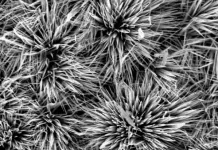Death enables complexity in chemical evolution
How to beat Spiegelman's monster
2021-03-17
(Press-News.org) Simple systems can reproduce faster than complex ones. So, how can the complexity of life have arisen from simple chemical beginnings? Starting with a simple system of self-replicating fibres, chemists at the University of Groningen have discovered that upon introducing a molecule that attacks the replicators, the more complex structures have an advantage. This system shows the way forward in elucidating how life can originate from lifeless matter. The results were published on 10 March in the journal Angewandte Chemie.
The road to answering the question of how life originated is guarded by Spiegelman's monster, named after the American molecular biologist Sol Spiegelman, who some 55 years ago described the tendency of replicators to become smaller when they were allowed to evolve. 'Complexity is a disadvantage during replication, so how did the complexity of life evolve?' asked Sijbren Otto, Professor of Systems Chemistry at the University of Groningen. He previously developed a self-replicating system in which self-replication produces fibres from simple building blocks and, now, he has found a way to beat the monster.
Death
'To achieve this, we introduced death into our system,' Otto explains. His fibres are made up of stacked rings that are self-assembled from single building blocks. The number of building blocks in a ring can vary, but stacks always contain rings of the same size. Otto and his team tweaked the system in such a way that rings of two different sizes were created, containing either three or six building blocks.
Under normal circumstances, fibres that are made up of small rings will outgrow the fibres with larger rings. 'However, when we added a compound that breaks up rings inside the fibres, we found that the bigger rings were more resistant. This means that the more complex fibres will dominate, despite the smaller rings replicating faster. Fibres that are made from small rings are more easily "killed".'
Experiments
Otto acknowledges that the difference in complexity between the two types of fibres is small. 'We did find that the fibres from the larger rings were better catalysts for the benchmark retro-aldol reaction than the simpler fibres that are made from rings with three building blocks. But then again, this reaction doesn't benefit the fibres.' However, the added complexity protects the fibres from destruction, probably by shielding the sulphur-sulphur bonds that link the building blocks into rings.
'All in all, we have now shown that it is possible to beat Spiegelman's monster,' says Otto. 'We did this in a particular way, by introducing chemical destruction, but there may be other routes. For us, the next step is to find out how much complexity we can create in this manner.' His team is now working on a way to automate the reaction, which depends on a delicate balance between the processes of replication and destruction. 'At the moment, it needs constant supervision and this limits the time that we can run it.'
Variants
The new system is the first of its kind and opens a route to more complex chemical evolution. 'In order to achieve real Darwinian evolution that leads to new things, we will need more complex systems with more than one building block,' says Otto. The trick will be to design a system that allows for the right amount of variation. 'When you have unlimited variation, the system won't go anywhere, it will just produce small amounts of all kinds of variants.' In contrast, if there is very little variation, nothing really new will appear.
The results that were presented in the latest paper show that, starting from simple precursors, complexity can increase in the course of evolution. 'This means that we can now see a way forward. But the journey to producing artificial life through chemical evolution is still a long one,' says Otto. However, he has beaten the monster guarding the road to his destination.
Simple Science Summary
One of the big questions in science is how life can originate from lifeless matter. Chemists at the University of Groningen have developed a system in which self-replicating fibres evolve. However, self-replicating systems generally favour more simple replicators since they replicate faster. Through 'survival of the simplest', systems will never produce the complexity that is necessary for life. This problem was solved by adding a substance that can break up the replicators, it 'kills' them. It turned out that more complex replicators are protected against this destruction, which means that in the presence of death, complex replicators can outcompete simpler ones.
INFORMATION:
Reference: Shuo Yang, Gael Schaeffer, Elio Mattia, Omer Markovitch, Kai Liu, Andreas S. Hussain, Jim Ottelé, Ankush Sood and Sijbren Otto: Chemical Fueling Enables Molecular Complexification of Self?Replicators. Angewandte Chemie 10 March 2021
[Attachments] See images for this press release:

ELSE PRESS RELEASES FROM THIS DATE:
2021-03-17
Many people who embrace social welfare programs vote against their own interests, according to new UC Riverside research.
The mitigating factor is education: The more education one has, the more likely one is to stick to one's policy preferences.
"It means candidates who employ tactics such as fear and attaching patriotism to certain concepts can persuade people to vote for candidates who are in opposition to their social beliefs," Diogo Ferrari, a professor of political science at UC Riverside, wrote in his recently published paper, "Education, Belief Structures, Support for Welfare Polices, and Vote," published in the journal Education & Society.
For the study, Ferrari looked at public opinion ...
2021-03-17
Brazilian researchers have published a systematic review of the scientific literature showing that some warm-up strategies such as dynamic stretching can effectively prepare soccer players to maintain kicking accuracy, whereas intense physical exercises have a negative effect on the velocity of the ball when kicked, and consumption of carbohydrate beverages during a match can enable players to maintain adequate kicking performance in the concluding moments of prolonged physical exercise such as a sudden-death playoff.
The review, published in the journal Sports Medicine in December 2020, ...
2021-03-17
COLUMBUS, Ohio - Electricity may slow - and in some cases, stop - the speed at which breast cancer cells spread through the body, a new study indicates.
The research also found that electromagnetic fields might hinder the amount of breast cancer cells that spread. The findings, published recently in the journal Bioelectricity, suggest that electromagnetic fields might be a useful tool in fighting cancers that are highly metastatic, which means they are likely to spread to other parts of the body, the authors said.
"We think we can hinder metastasis by applying these fields, but we also think it may be possible to even destroy tumors using this approach," said Vish Subramaniam, senior author of the paper and former professor of mechanical ...
2021-03-17
PHILADELPHIA (March 17, 2021) - Stroke remains a leading cause of death worldwide and one of the most common reasons for disability. While a wide variety of factors influence stroke outcomes, data show that avoiding readmissions and long lengths of stay among ischemic stroke patients has benefits for patients and health care systems alike. Although reduced readmission rates among various medical patients have been associated with better nurse work environments, it is unknown how the work environment might influence readmissions and length of stay for ischemic stroke patients.
In a new study from the University of Pennsylvania School of Nursing's (Penn Nursing) Center for Health Outcomes ...
2021-03-17
The NASA-funded Seismometer to Investigate Ice and Ocean Structure (SIIOS) performed well in seismic experiments conducted in snowy summer Greenland, according to a new study by the SIIOS team led by the University of Arizona published this week in Seismological Research Letters.
SIIOS could be a part of proposed NASA spacecraft missions to the surface of Europa or Enceladus. These moons of Jupiter and Saturn are encrusted by an icy shell over subsurface liquid oceans, and seismic data could be used to better define the thickness and depth of these layers. Other seismic points of interest on these worlds could include ice volcanoes, drainage events below the ice shell and possibly even ...
2021-03-17
East Hanover, NJ. March 17, 2021. Kessler Foundation researchers have identified several practical and technical barriers to the widespread use of surface electromyography (sEMG) in clinical neurorehabilitation. Based on their holistic analysis of these factors, the researchers suggest a collaborative, interdisciplinary, and unified approach to enable rehabilitation professionals to routinely use sEMG. The article, "Use of Surface EMG in Clinical Rehabilitation of Individuals With SCI: Barriers and Future Considerations" (doi: 10.3389/fneur.2020.578559), was published December 18, 2020, in Frontiers in Neurology. It is available open access at https://www.ncbi.nlm.nih.gov/pmc/articles/PMC7780850/
The authors are Rakesh ...
2021-03-17
Autoimmune diseases are typically caused when the immune system, whose purpose is to deal with foreign threats to the body, incorrectly recognizes the body's own proteins and cells as threats and activates immune cells to attack them. In the case of rheumatoid arthritis, a well-known autoimmune disease, immune cells erroneously attack the body's own joint components and proteins, causing painful inflammation and even the destruction of bone! Scientists from Japan have now taken a massive step toward understanding and, potentially, treating rheumatoid arthritis better, with their discovery in a brand-new study. Read on to understand how!
The development of autoimmune diseases is an incredibly complex process, involving several key players ...
2021-03-17
A sustainable, powerful micro-supercapacitor may be on the horizon, thanks to an international collaboration of researchers from Penn State and the University of Electronic Science and Technology of China. Until now, the high-capacity, fast-charging energy storage devices have been limited by the composition of their electrodes -- the connections responsible for managing the flow of electrons during charging and dispensing energy. Now, researchers have developed a better material to improve connectivity while maintaining recyclability and low cost.
They published their results on Feb. 8 in the Journal of Materials Chemistry A.
"The supercapacitor is a very powerful, energy-dense device with a fast-charging rate, in contrast to the typical battery ...
2021-03-17
An international collaboration between Great Ormond Street Hospital, the UCL GOS Institute for Child Health and Harvard Medical School has shown that the beneficial effects of gene therapy can be seen decades after the transplanted blood stem cells has been cleared by the body.
The research team monitored five patients who were successfully cured of SCID-X1 using gene therapy at GOSH. For 3-18 years patients' blood was regularly analysed to detect which cell types and biomarker chemicals were present in their blood. The results showed that even though the stem cells transplanted as part of gene therapy had been cleared by the patients, the all-important corrected immune cells, called T-cells, were still forming.
Gene therapy works by first removing ...
2021-03-17
In researching the causes and potential treatments for degenerative conditions such as Alzheimer's or Parkinson's disease, neuroscientists frequently struggle to accurately identify cells needed to understand brain activity that gives rise to behavior changes such as declining memory or impaired balance and tremors.
A multidisciplinary team of Georgia Institute of Technology neuroscience researchers, borrowing from existing tools such as graphical models, have uncovered a better way to identify cells and understand the mechanisms of the diseases, potentially leading to better understanding, diagnosis, and treatment.
Their research findings were reported Feb. 24 in the journal eLife. The research was supported by the National Institutes of ...
LAST 30 PRESS RELEASES:
[Press-News.org] Death enables complexity in chemical evolution
How to beat Spiegelman's monster






